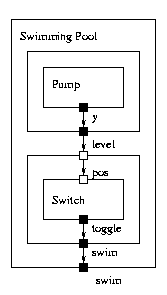The swimming pool example shows a system composed of two concurrent components: a pump, which maintains the water level in the pool, and a switch, which toggles the sign "swim/don't swim", according to the water level.

Variable

The pump has two states
// ------------------------------------------------------------------------
// behavioral hierarchy - modes
// ------------------------------------------------------------------------
// water pump - a hybrid component to control water level
mode Pump( int low, int high ) {
private analog real timer;
write analog real y;
mode on = SteadyMode( 1, 0, high );
mode off = SteadyMode( -2, low, 10000000 );
mode turnOn = TransientMode( -2 );
mode turnOff = TransientMode( 1 );
diff { d(timer) == 1; }
trans initTrans from default to on when true do { timer = 0; }
trans requestOff from on to turnOff when y >= 9.9 do { timer = 0; }
trans doneOff from turnOff to off when timer >= 1.9 do {}
trans requestOn from off to turnOn when y <= 5.1 do { timer = 0; }
trans doneOn from turnOn to on when timer >= 1.9 do {}
}
mode SteadyMode( int rate, int low, int high ) {
write analog real y;
diff { d(y) == rate; }
inv s1{ y >= low && y <= high }
}
mode TransientMode( int rate ) {
write analog real y;
read analog real timer;
diff { d(y) == rate*(1-timer/2) }
inv { timer <= 2 }
}
// ------------------------------------------------------------------------
// switch - a discrete component to highlight the sign
mode Switch( int threshold ) {
write discrete bool toggle;
read analog real pos;
mode on = empty();
mode off = empty();
trans init1 from default to on when true do { toggle = true; }
//trans init1 from default to on when pos <= threshold do { toggle = true; }
//trans init2 from default to off when pos >= threshold do { toggle = false; }
trans toOff from on to off when pos < threshold do { toggle = false; }
trans toOn from off to on when pos > threshold do { toggle = true; }
}
mode empty() { }
// ------------------------------------------------------------------------
// architectural hierarchy - agents
// ------------------------------------------------------------------------
// the pump agent
agent APump( int low, int high ) {
write analog real y;
init { y = 1.0; }
mode top = Pump( low, high );
}
// ------------------------------------------------------------------------
// the switch agent
agent ASwitch( int threshold ) {
write discrete bool toggle;
read analog real pos;
mode top = Switch( threshold );
}
// ------------------------------------------------------------------------
// the swimming pool with a switch and a pump
agent SwimmingPool() {
private analog real level;
write discrete bool swim;
agent pump = APump( 5, 10 ) [ y := level ]
agent sign = ASwitch( 7 ) [ pos, toggle := level, swim ]
}